If I had a dollar for every time someone priced a $500 course at $10 hoping to “attract more customers,” I’d have enough to launch a very profitable course on how not to do that. Seriously, it happens all the time.
Chipo's Insight
You pour your heart into building something transformational. Then the pricing panic hits. Suddenly, you’re second-guessing everything: Should I charge less to get more signups? More to look premium? Should I offer a discount and hope for the best?
Here’s the uncomfortable truth: your price can make or break your student conversion rate. In fact, most online courses convert at just 1.5% to 2%, with 5% considered exceptional . And contrary to popular belief, underpricing doesn’t guarantee more sales — it can actually lower perceived value and turn off serious buyers.

So no, this isn’t the part you want to “just feel out.”
And that’s we’re about to dive straight into pricing strategies for online courses that are built for real-world conversion — not guesswork. You’ll learn how to price your course using value-based pricing, structure smart course pricing tiers, and align your pricing model with your course funnel, audience, and business goals.
I’ll also talk about subscription models, premium course pricing, and how your price affects everything from launch to recurring revenue.
Let’s fix this pricing indecision now, so you can start thriving.
Your Price Is the Strategy — Not Just the Number
Hear this loud and clear: your course price serves as a clear message to your potential customers.
Before anyone clicks “Buy Now,” that price tag is already telling a story.
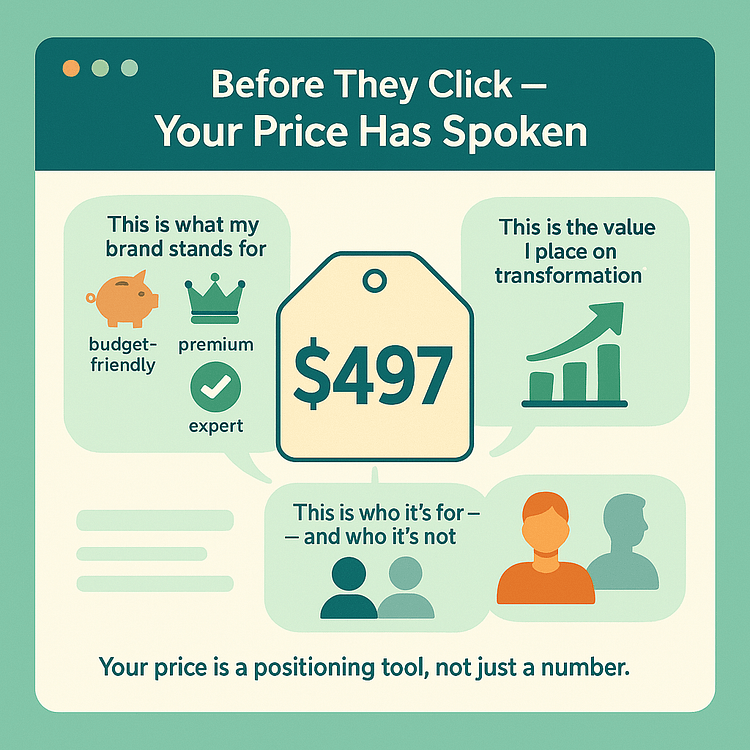
So no, pricing is not the final cherry on top. It’s the front door to your offer and if the number on it feels off, the right students won’t walk through it.
Still not convinced? Let’s talk reach vs. reality. If you price your course at $10 and want to make $5,000, you’ll need 500 sales — which could mean attracting over 20,000 visitors to your page. But if your course is $1,000? You only need 5 buyers to hit the same revenue, and a fraction of the audience size to get there.
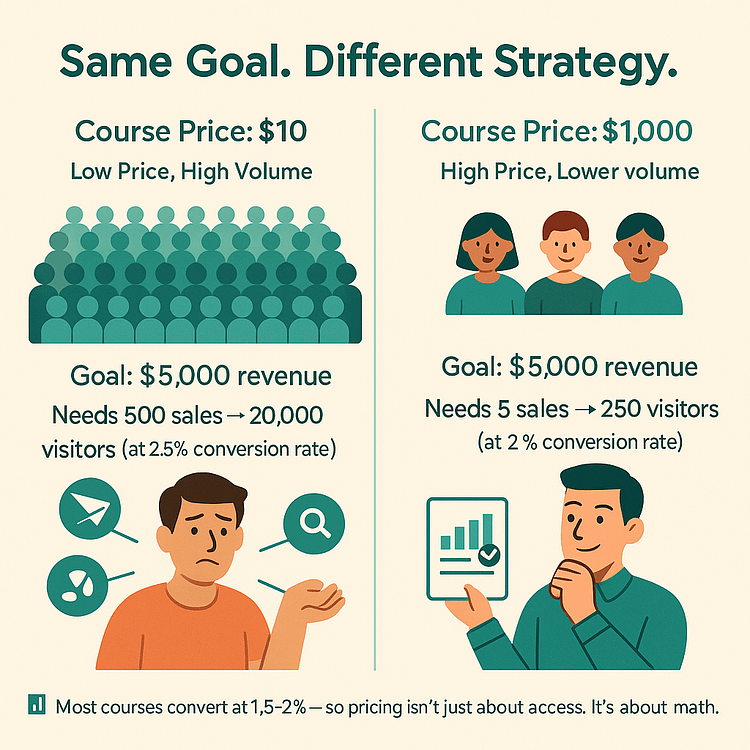
And with most online courses converting at just 1.5% to 2% (remember this stat from earlier?), the margin for error? It’s small. That’s why strategic pricing isn’t non-negotiable.
😬 Worried you might’ve committed a pricing sin or two already?
This guide on pricing mistakes to avoid will help you spot (and fix) the most common conversion killers before they cost you sales.
Real Talk: Your Price Only Works If Everything Around It Does Too
Come, let me tell you something I’ve learned the hard way: you can have the perfect price, but if the rest of your funnel feels clunky, unprofessional, or slapped together — people won’t buy.
It’s not just about the number you put on the sales page.
It’s about the experience that surrounds it.
Because the truth is… if your funnel feels cheap, your course will too. And that instantly undercuts whatever pricing strategy you’re trying to implement.
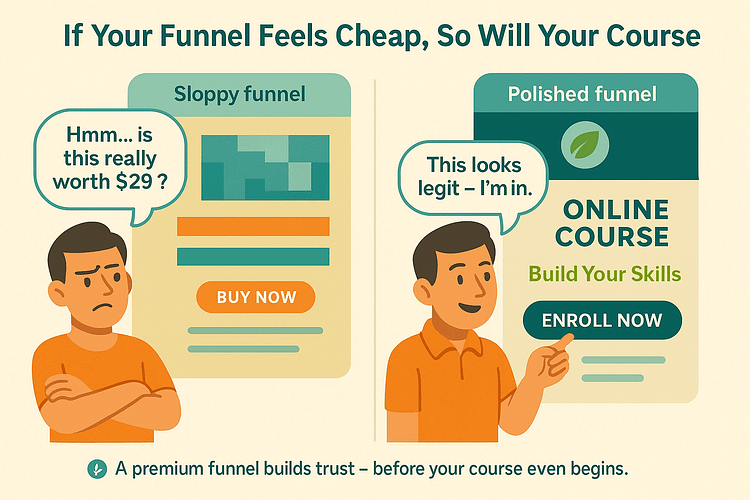
Chipo's Insight
That’s why I stopped piecing everything together with five different plugins and just moved to Thrive Suite.
It gave me the flexibility to build a funnel that actually matches the value I’m delivering — not just patch one together and hope for the best.
Most importantly?I finally had Thrive Apprentice — a course platform that looks and feels as premium as the content I worked so hard to create.
Here’s what changed for me:
I designed sleek, conversion-focused course landing pages with Thrive Architect
I tested different pricing offers and layouts using Thrive Optimize
I added opt-ins, countdowns, testimonials, and dynamic CTAs — all within the same ecosystem
And with Thrive Apprentice, I delivered the course experience my audience expected at that price point
💡 Because when your course and funnel both feel high-value, buyers don’t second-guess the price — they say yes.
If you want to charge like a pro, your whole system has to look and work like one. Thrive made that possible for me — and it’s what I recommend if you want your pricing to land the way it should.
Alright, now let’s dive into the strategies themselves.
High-Converting Pricing Strategies for Online Courses
Alright, we’ve covered why your price isn’t just a number but a key part of your course funnel and brand story.
Now let’s get into the how.
These are the pricing strategies for online courses I’ve seen work over and over — whether you’re launching your first digital course or optimizing a premium course pricing setup.
They’re built to increase your student conversion rate, grow recurring revenue, and align with the actual transformation your course delivers.
You’ll also see how to apply each strategy using Thrive Suite tools (along with a few proven course marketing tactics), so you’re not just guessing. You’re building a funnel — and a course pricing model — that’s made to convert.
Let’s break them down.
Price Based on Perceived Value, Not Content Volume
Here’s something I wish more creators understood: your course isn’t valuable because it has 42 lessons and a bonus PDF. It’s valuable because it solves a problem and delivers a clear transformation.
In fact, according to Podia’s research, 89% of online courses are priced at $350 or less — but the creators charging $1,000+? They’re not winning on quantity. They’re winning on perceived value.
Chipo's Insight
This is where so many pricing mistakes happen. Creators cram in extra content, thinking more equals worth more. But your students aren’t buying information. They’re buying the result — the confidence, the clarity, the skillset, the freedom — whatever your course helps them unlock.
If you want to move toward premium course pricing, try framing your offer using the problem → path → promise method:
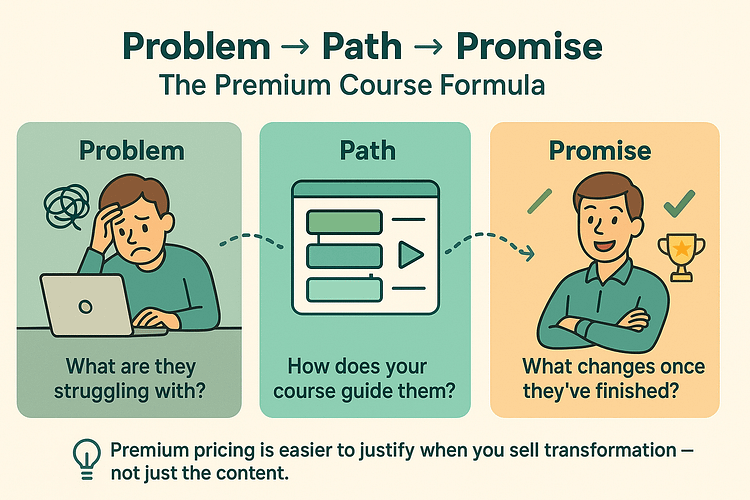
That shift alone will do more for your digital course sales than any “add one more lesson” tactic ever could.
Thrive Tip: Use Thrive Quiz Builder to segment your audience by pain point or goal, then direct them to the tiered offer that makes the most sense. It’s a simple way to make your online course pricing model feel more tailored — and more valuable.
✅ TL;DR: Stop pricing based on how much content you’ve created. Price based on what your students actually walk away with.
Test Willingness to Pay Before You Launch
One of the biggest mistakes I see with online course pricing models? Waiting until launch day to decide what you’ll charge — and then hoping it lands.
Your course launch strategy should never be a shot in the dark. Smart pricing starts before you open your cart.
And no, you don’t need a massive list or deep analytics setup. You just need a few well-placed tools — and a mindset that treats pricing as part of your course marketing tactics, not an afterthought.
Here’s how to keep it simple but strategic:

This is real-world feedback.
In fact, Unbounce reports that testing pricing and presentation can boost trial signups by up to 104%. That kind of lift can make or break your student conversion rate.
Here’s your tool stack:
This approach is especially useful if you’re thinking about course pricing tiers, a subscription model for courses, or planning a shift toward premium course pricing down the line.
✅ Bottom line: The earlier you test, the more confident you’ll be — and the stronger your revenue foundation will become.
Choose a Model That Matches Your Funnel — and Growth Goals
Chipo's Insight
I’ve talked more entrepreneurs than I can count off the ledge of “low-cost pricing to build a crowd”. Because here’s the truth: just slapping a $27 price tag on your course doesn’t guarantee volume — or loyalty — or sales. It just undervalues your offer.
What a lot of people don’t realize is that you do have options. Real ones.
There’s no one-size-fits-all when it comes to online course pricing models. The best creators I know build their pricing around the transformation they offer — and the kind of business they want to run.
Some go for recurring revenue with a subscription model for courses. Others lean into premium course pricing with a high-touch experience. Some use course pricing tiers to serve different audience segments in one funnel.
So before you undercharge and overwork yourself, take a beat. Let’s look at the models that actually work — and help you choose the one that’s built for your version of success.
🧭 Quick Comparison: Online Course Pricing Models
Now let’s break down how to use each one strategically — not just what they are, but how they work inside your funnel and business model.
Pricing Model | What It Is | When to Use It | Tools |
|---|---|---|---|
One-Time | A single upfront payment for full course access. | Best for evergreen courses or certifications with defined start and end points. | All-in-one: landing pages, email, checkout, simple automations |
Subscription | Recurring payments (monthly/yearly) for continued access. | Ideal for memberships, ongoing content, or community access. | Thrive Apprentice |
Installments | Payment split into 2–6+ monthly chunks. | Great for high-ticket courses where price sensitivity is a barrier. | ThriveCart, Stripe, or Square |
Freemium | Free entry-level access with upsells inside. | Powerful for lead generation, building trust, and email list growth. | Thrive Leads + gated Apprentice content |
Tiered Pricing | Multiple package levels with increasing value. | Perfect when your audience has different budgets or commitment levels. | Thrive Architect + Smart Content Blocks |
One-Time Pricing
Think of this as your classic digital course sale: one payment, full access.

🛠 Thrive Tip: Use Thrive Apprentice with Stripe or Square integration to deliver a polished, friction-free checkout and instant course access.
Subscription Model
A monthly or yearly payment structure where students get ongoing value — and you build reliable recurring revenue.
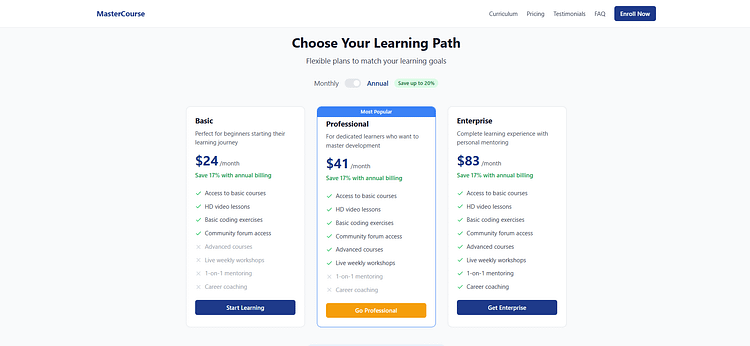
🛠 Thrive Tip: Use Thrive Apprentice’s drip content and community tools to keep students coming back.
Installments
Split your premium course pricing into manageable monthly chunks.
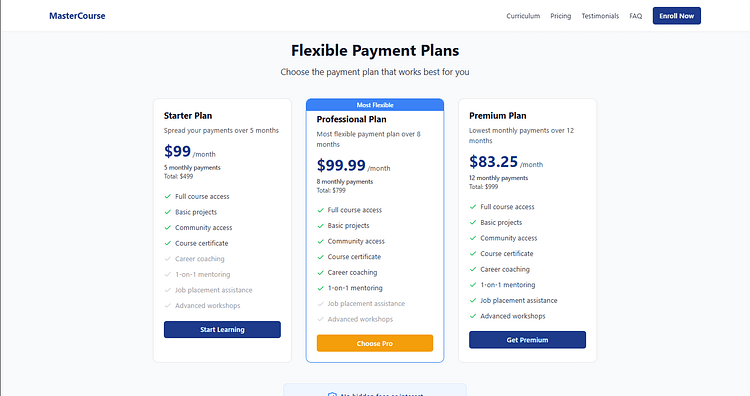
Freemium
Let students preview the value before they pay — and use that experience to build trust.
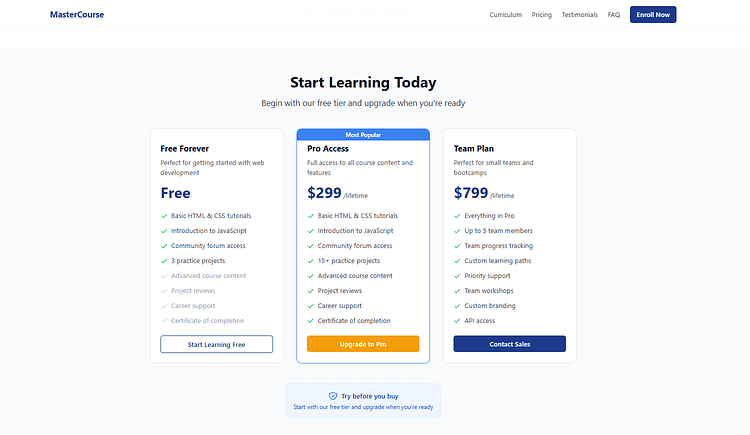
🛠 Thrive Tip: Use Thrive Leads to offer a gated free module or mini-course inside Thrive Apprentice — then upsell based on engagement.
Tiered Pricing
Offer multiple packages with increasing levels of value — think Basic, Pro, and VIP.
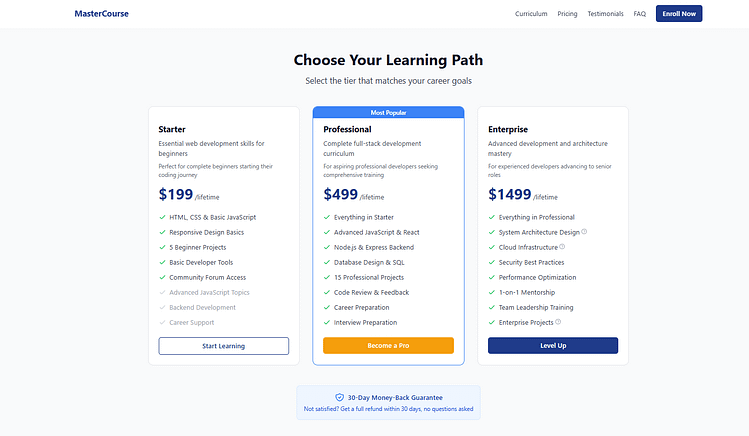
🛠 Thrive Tip: Use Thrive Architect with Smart Content Blocks to create tiered pricing sections that feel personal and aligned to different buyer types. And learn more about building membership tiers right here.
✅ TL;DR: Your pricing model should reflect your offer’s structure and your customer’s buying journey. Pick the one that supports how you sell, how you teach, and where your business is headed.
Add Bonuses and Stack Value Strategically
Chipo's Insight
I've seen it happen more times than I can count: two creators launch similar online courses — one at $497, the other struggling to sell at $99. The difference? Perceived value, not content volume.
Your pricing strategy is about what those numbers represent. And bonuses? They’re your shortcut to making that price feel like a no-brainer. You're not just offering modules. You're offering an experience — and that includes the tools, support, and surprises that make your course feel premium.
But here’s the real key: it has to feel intentional. When your bonuses are deeply tied to the transformation you're promising, they don’t just justify the price — they elevate it.
Here’s how to make it work without turning it into a grab bag:

These aren't just cute extras — they tap into proven course marketing tactics like scarcity, exclusivity, and incentive-driven behavior. Used wisely, they can dramatically improve your student conversion rate without dropping your price.
✅ Bottom line: The right bonus, offered at the right time, doesn’t just add value — it pushes someone from “maybe later” to “enrolling now.”
Use Psychology (Ethically) to Drive Signups
You don’t need to manipulate people to get conversions. But you do need to understand how they make decisions — especially when money’s involved. Pricing psychology is one of the most overlooked tools in your digital course sales arsenal. Small tweaks can have a big impact on your student conversion rate — when done with intention.
Here’s how to apply it the smart (and ethical) way:
These tactics tap into value-based pricing, buyer behavior, and conversion psychology — all without compromising trust.
Thrive Tip: Use Thrive Ultimatum to create real urgency — like a time-sensitive early bird discount — triggered by behavior (not artificial countdowns). That means no sleazy timers... just context-driven scarcity that works.
✅ Bottom line: These details might seem small — but when you’re selling at scale, they can be the difference between “meh” and fully booked.
Make Testing a Habit, Not a Hail Mary
Chipo's Insight
Now, you probably think that once you’ve set your course price, you’re done. You’ve picked the number, slapped it on the page, and now it’s time to focus on marketing, right?
Wrong.
Pricing is never a “set it and forget it” decision. It’s a living part of your course funnel — and if you want your student conversion rate to grow, you’ve got to treat it like something worth optimizing.
💡 Here’s why it matters: A/B testing can improve conversion rates by up to 49%, according to Invesp. And yes — that includes testing your course price, offer framing, and bonus stacking, not just button colors.
Testing doesn’t mean you’re second-guessing your value. It means you’re serious about understanding how your audience responds to it — and you’re willing to adapt for smarter digital course sales.
Tools That Make It Easy:
✅ Bottom line: Testing is how your pricing stays sharp, relevant, and aligned with your audience. And when you make it a habit, you don’t just keep up — you stay ahead.
Think Beyond the Obvious (Where the Real Conversion Wins Happen)
You’ve priced your course, polished the pitch, maybe even launched once or twice. But still feel like something’s missing? Chances are, it’s this: You’re playing within the lines — and your pricing looks like everyone’s else. The most memorable pricing strategies don’t just follow best practices. They make your audience pause and think, “Wait… is this made just for me?”
This is where pricing gets personal. Where value-based pricing and course marketing tactics intersect to create something way more powerful than a flat dollar amount.
Try these 3 conversion-smart moves:
✅ Bottom line: People don’t just want to be convinced — they want to feel seen. When your pricing adapts to their behavior, preferences, and journey, you build more than revenue. You build loyalty.
Out-of-the-Box Pricing Tactics That Just… Work
Most people stop at price tiers and discount codes. But if you want to actually stand out — and boost your student conversion rate — sometimes you need to color outside the lines. These aren’t your standard “$199 or $999” playbook moves. They’re the kind of tactics that make someone lean in, feel a spark of delight, and click Buy because your offer doesn’t just look good — it feels personal, smart, and impossible to ignore.
Here are a few unexpected, conversion-focused pricing moves you can build with Thrive tools — plus a sprinkle of creative automation.
Let Users “Build Their Own” Offer
Sometimes, the best way to sell your course... is to stop treating it like a fixed-price menu. Instead of rigid tiers, let your users mix and match their own experience — adding coaching calls, bonus modules, downloadable templates, or anything that aligns with their goals.
It turns your course pricing tiers into something interactive and tailored — which builds ownership and increases conversions.
Thrive Tip: A product recommendation quiz with branched logic is a fantastic way to tailor your course pricing to your audience’s needs and interests.
✅ Gives users control — and makes your premium tier feel like it was made just for them.
Use “Founding Member” Pricing — But Make It Disappear
Everyone loves a first-mover advantage — and that’s what founding member pricing is all about. Offer a special early-buyer rate during launch, but make it genuinely time-limited or capped after a specific number of sales.
How to do it:
✅ Scarcity works when it’s real. This tactic builds trust, not FOMO fatigue.
Add a Mystery Bonus to the Premium Tier
Nothing creates delight quite like a surprise — especially one you only get after buying. Include a “mystery bonus worth $X” in your highest course tier and reveal it after checkout. It could be a surprise Zoom invite, a hidden module, or an invite to an exclusive community.
Automation tip:
✅ This small move makes your premium course pricing feel fun, elevated, and like a VIP experience.
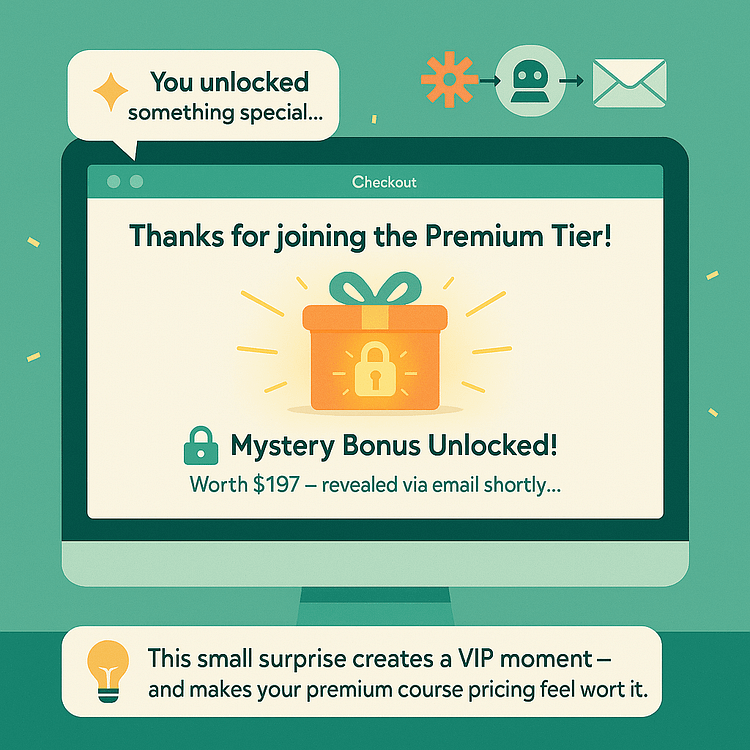
FAQs — Smart Answers to Your Top Pricing Questions
Start with the transformation your course delivers — not just the content volume. That’s the foundation of value-based pricing. Then, validate your assumptions with audience research, pre-launch opt-ins, and real-time testing. The best online course pricing models are shaped by data — not guesswork.
✅ Tools like Thrive Leads, quizzes, and waitlists let you measure real interest and student conversion rate at different price points before you go live.
Strategic discounts can work wonders — especially when tied to events like a course launch strategy, alumni campaigns, or early bird offers. But avoid random or frequent discounts. They can undermine your perceived value and make it harder to raise prices later.
✅ Use Thrive Ultimatum to run ethical, time-sensitive campaigns that align with your course funnel — not gimmicks. Justify every price drop with purpose.
It depends on your offer and growth goals. A subscription model for courses works well for long-term access, ongoing content, or community-driven learning. It’s great for generating recurring revenue. A one-time payment is ideal for transformation-focused courses with a clear end result — and gives you upfront cash flow.
✅ Both models can work inside Thrive Apprentice. Match the model to your digital course sales funnel and how you deliver value over time.
Start with small A/B tests — even testing things like:
- $297 vs. $349
- Discounted vs. full-price framing
- Tiered offer vs. flat rate
- Bonus included vs. not included
✅ Use Thrive Optimize to run controlled experiments across your course pricing tiers and landing pages. And don’t just track sales — watch engagement, completion rates, and upsell success too.
Conclusion: Pricing Strategies for Online Courses That Actually Grow Your Business
If you’ve ever stared at a blank pricing page, second-guessing yourself — you’re not alone. Pricing your course isn't just hard. It’s emotional. You’re putting a value on your work, your knowledge, your time — and hoping people see what it’s worth.
Chipo's Insight
But here’s the truth: strong pricing strategies for online courses don’t come from guesswork. They come from confidence — backed by data, clarity, and the right tools to test what actually works.
When you focus on value-based pricing, tailor your course funnel to match, and use Thrive Suite to optimize every part of the journey… You’re not just selling a course. You’re building a system that converts — consistently.
👉 Ready to build dynamic pricing pages, launch optimized offers, and test smarter? Start with Thrive Suite — and make every offer count.


